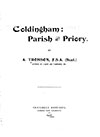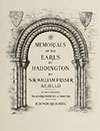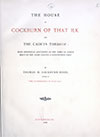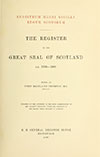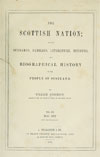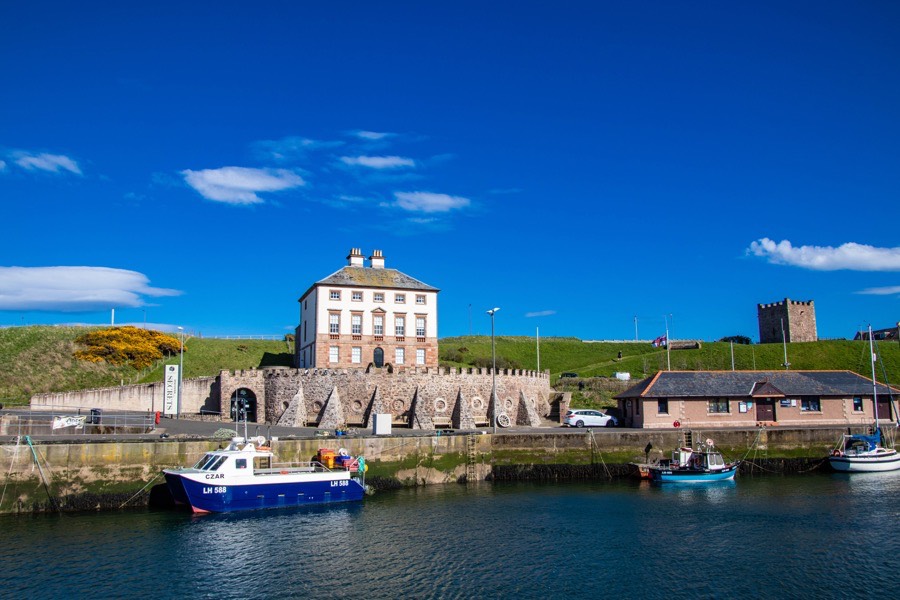

A tower house named Gunsgreen is marked on Gordon’s mid-17th century map of The Merse, although its exact location is unknown and there is now a mid-18th century mansion at Gunsgreen.
The earliest mention of Gunsgreen is in 1542 when the “terrae de Gunisgrene” was in the possession of Sir Patrick Home of Fast Castle. It seems to have originally been a part of the larger estate of Flemington or Flemingtoun which was held by the Home family.
What form the original castle took is unclear, however it is entirely possible that it could have been a strong tower of a type typical across the Borders. It seems to have been one of a chain of such towers running inland along the south side of the Eye Water.
The exact location of the tower is not known although at least one source suggests that it was not in the location now occupied by Gunsgreen House. However there are extensive cellars under the house which may pre-date the structure above and could represent the basement level of an old tower. This position affords easy access to the river and sea while being largely hidden to the south and east.
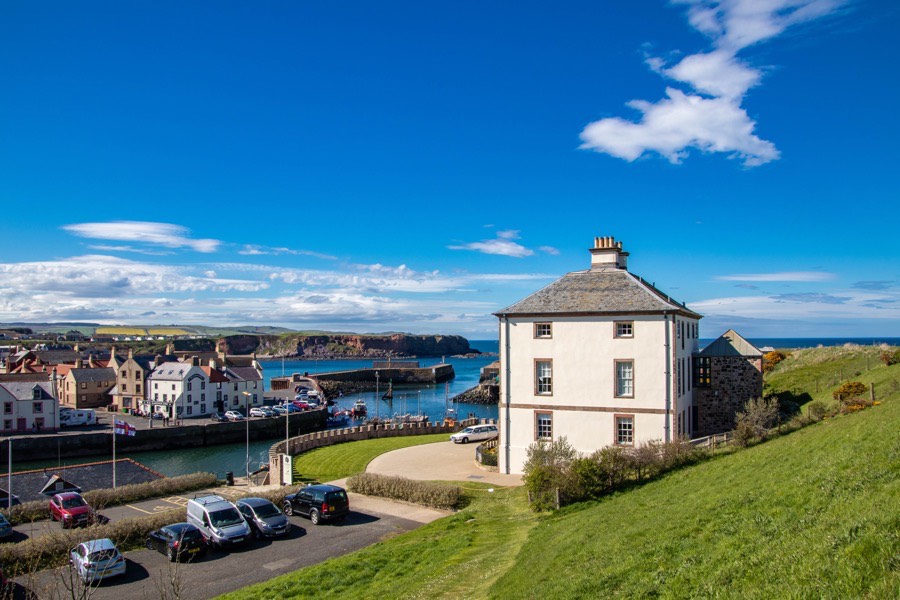
Some time before 1550 the Auchincraw family seem to have acquired the lands of Netherbyres, Gunsgreen and Flemington. A James Auchincraw of Gunsgreen is mentioned in a document from 1575, and he was referred to again in court in 1583 along with Alexander, Lord Home, Alexander Home of Hutounhall and David Home of Nynwells. It may be that the Homes leased Gunsgreen to Auchincraw.
An Instrument of Sasine from 1587 in favour of a William Home regarding other properties was witnessed by a David Craw of Gunsgreen, who was mentioned again in 1592. The names Craw and Auchincraw seem to have been interchangeable during this period so it may be that James Auchincraw and David Craw were related.
Gunsgreen then seems to have returned to the Home family as Robert Logan of Restalrig, who was married to Elizabeth Home, the daughter of Sir Patrick Home of Fast Castle, signed letters relating to the Gowrie conspiracy 16th of October 1597 at Gunsgreen. In a grant from 1598 James VI confirmed to Robert Logan of Restalrig “the lands of Flemington, called Nethyr Aitoun, Reidhall, Nethir Byre, Brounisland, Gunisgrene, with the Manor of Gunisgrene”.
It may be therefore that the Auchincraw / Craw family feued those properties from the Homes rather than owning them outright. Before Logan’s death in 1606 he disposed of the aforementioned lands to George Home, Earl of Dunbar, the third son on Sir Alexander Home of Manderston. It is said that soon afterwards the lands were bought by James Craw of East Reston, although it isn’t clear if this refers to the whole lands of Flemington or just Netherbyres. Craw’s descendants are said to have held the Netherbyres part of the estate until the first half of the 19th century
The Earl of Dunbar died in 1611 and in 1614 Lady Anna Home, one of his two daughters and heiresses, feued four husband-lands of Gunsgreen to Alexander Lauder, a great-great-grandson of Sir Robert Lauder of The Bass, and his wife Christian Clapperton. The same feu-contract granted twelve husband-lands of Netherbyres and Redhall to a William Craw, perhaps again suggesting that the Auchincraw / Craw family feued the lands from the Homes.
In 1616 the late James Auchincraw of Gunsgreen is mentioned in a charter and in 1617 Alexander Lauder of Gunsgreen is mentioned in a charter which was signed at Gunsgreen. The property may subsequently have been occupied by the Home family again as in 1620 a document was signed there in favour of Sir George Home of Manderston. Lauder is known to have acted as bailie for Sir David Home of Wedderburn in 1629.

Robert Gordon, c. 1636 – 1652map image courtesy of NLS
Alexander Lauder’s son, Robert Lauder of Gunsgreene, is mentioned in a document from 1637 and later married Anna, daughter of William Congalton of Congalton. Following Lauder’s death she married Patrick Scougal, Bishop of Aberdeen, and upon her death in 1706 she was described as Anna Congalton, Lady Gunsgreen.
At the northern end of the lands of Gunsgreen the remains of a quadrangular tower, said to have been built by Cromwell, could still be seen until the late 18th century.
By 1753 Gunsgreen was owned by John Nisbet, a wealthy local merchant, and in the same year he commissioned James Adam to build him a mansion. The result was a five bay Palladian villa consisting of three storeys plus a part-sunken basement, built over the cellars beneath.

Interestingly a James Nisbet, a mason and architect born in Kelso, later supervised the building of the John Adam-designed Paxton House in 1759 and was involved in the building of Eyemouth harbour around 1768. Whether or not he was related to the Eyemouth Nisbets I have not been able to ascertain, but it’s an interesting Nisbet and Adam link nonetheless.

As well as Nisbet’s legitimate business he was a prolific smuggler, and the house was full of voids in which to stash illicit goods. The house was alluded to in Parliament when an MP referred to the amount of smuggling going on in the east of Scotland as allowing one man to build a splendid palace with the proceeds.
An Instrument of Sasine from 1758 by William, John and David Nisbet refers to “the lands of Fleemingtoun, called Gunsgreen” recalling the Gunsgreen estate’s earlier origins as part of the lands of Flemington. Confusingly the Gunsgreen estate seems to have been bought by Patrick Home of Billie (and later of Wedderburn) in 1764 but was still owned by the Nisbets some years later. It may be that he bought some land parcelled off from the main estate rather than the house itself, although this is just supposition on my part.
In 1789 John Nisbet was declared bankrupt and as a result of a court case brought by his rival, Alexander Robertson of Prenderguest. Robertson subsequently bought Gunsgreen House at auction in Edinburgh. In 1804 Alexander’s eldest son Robert is described as of Prenderguest, Brownsbank and Gunsgreen.
A semi-circular castellated terrace with large buttresses on the retaining wall in front of the house is thought to date to the early 19th century and hides the old cellars behind.


To the south of the main house on higher ground is a small castellated building variously described as a cart shed or doocot. It is thought to have been built in the 19th century but seems to incorporate some much older architectural details. A stone drain spout projects from each of the east and west walls, two seemingly out of place corbel details can be seen above the entrance in the south wall and eight vertical loopholes have been arranged to form two cross details, one on each of the west and north walls.


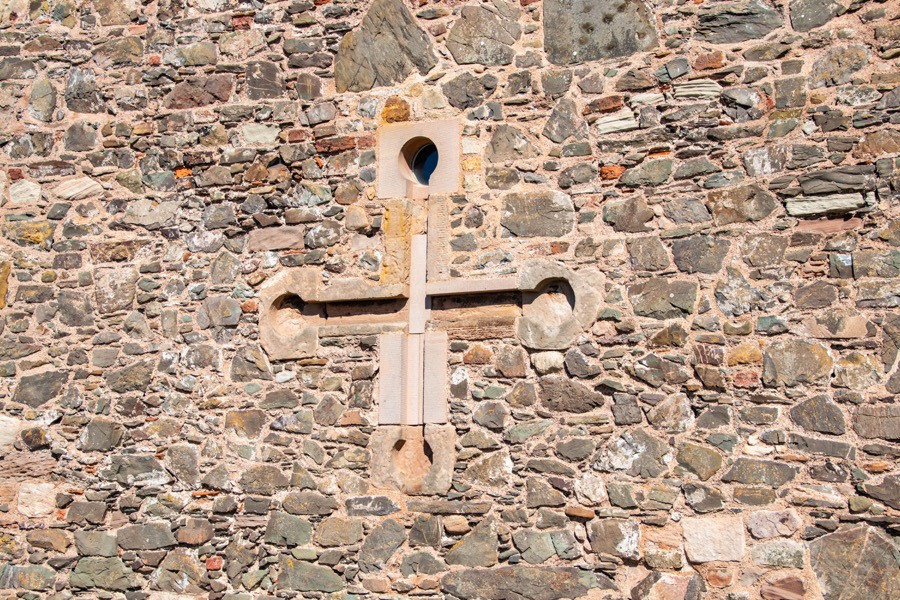


Following Alexander Robertson’s death in 1804 the house passed to his sister, Margaret, and her husband, Reverend George Home, the minister of Ayton. Gunsgreen was sold by the Robertsons in the 1830s for £18,000, possibly to the Homes since Reverend Abraham Home died at Gunsgreen in 1856. In 1866 it was owned by Dr Patrick Home of Gunsgreen and Windshiel but occupied by a J.G. Wood of Edinburgh. The house seems to have been rented out by the Homes as a William Shaw gives Gunsgreen as his address in 1868 and 1872.
In 1881 the house and estate was sold by a Miss Home to a James Gibson for £22,000, the estate consisting at that time of 520 acres which had an annual value of £852. By 1912 the house was rented by a local fisherman, William Dougal, and his wife, Wilhelmina, who ran it as a boarding house. It continued in this guise until the 1960s when it became the clubhouse for Eyemouth Golf Club around the middle of that decade.
At some point it seems to have come into the ownership of Scottish Borders Council and by 1998 Gunsgreen House was empty and virtually abandoned. The Gunsgreen House Trust was established in the same year and leased the building from the Council, restoring it to its former glory. In 2009 Gunsgreen House opened as a museum.
Alternative names for Gunsgreen
Ginsgrein; Gownisgrein; Gunisgrene; Gunnisgrene; Gunnsgreene; Gunsgrene






